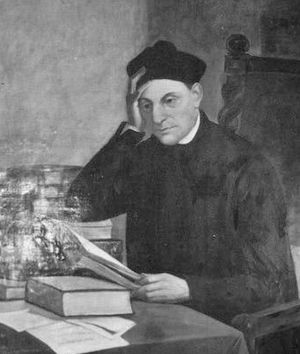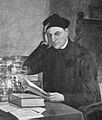Manuel Lacunza facts for kids
Quick facts for kids
Manuel de Lacunza, S.J.
|
|
|---|---|

Lacunza through the eyes of 19th century artist Alexander Ciccarelli
|
|
| Born | July 19, 1731 |
| Died | c. 18 June 1801 Imola, Cisalpine Republic
|
| Occupation | Priest |
| Known for | Expositor of Bible prophecies |
Manuel De Lacunza (born July 19, 1731 – died around June 18, 1801) was a Jesuit priest from Chile. He wrote a very important book about Bible prophecies. He used a secret name, Juan Josafat Ben-Ezra, for his main book. It was called The Coming of the Messiah in Majesty and Glory.
Contents
Manuel Lacunza's Life Story
Manuel was born in Chile in 1731. His parents, Carlos and Josefa Diaz, were rich traders. In 1747, when he was 16, Manuel joined the Society of Jesus, also known as the Jesuits. They are a group of Catholic priests.
He became a priest in 1766. He started teaching grammar at a university in Chile. He was also known for being a good speaker in church.
Exile and Hardship
In 1767, the King of Spain, Charles III of Spain, forced all Jesuits to leave Spain and its lands. This included South America. So, Lacunza had to go into exile. First, he went to Spain, then to Imola, a town in Italy. Many other Chilean Jesuits found a home there too.
Life was hard for Lacunza. The king threatened to stop giving money to any Jesuit who spoke against the king's decision. Later, the Pope also made it harder for Jesuits to perform church services. Also, Lacunza's family in Chile faced money problems. This meant he received less money from them.
Years of Study
During this difficult time, Lacunza started studying a lot. He read about early Christian thinkers. Then, he focused on Bible prophecies. After 1779, he only studied the Bible.
He lived with other exiled Jesuits for five years. Then, he moved to a house outside Imola. He lived alone, except for a helper he called "my good mulatto." People who knew him admired his simple life. They said he worked very hard at his studies.
In 1773, the Pope officially ended the Jesuit order. This meant Lacunza was no longer a Jesuit priest by law. This was a big personal challenge for him.
His Main Work
Because of his studies and personal struggles, Lacunza started to believe in a special future event. He thought Jesus would return to Earth before the very end of the world. He first shared these ideas in a short paper. It was called "The Anonymous Millennium." This paper was shared widely in South America. It caused big debates. Some people reported him to the Inquisition, a church court. They banned his paper.
In 1790, Lacunza finished his main book. It was called "The Coming of the Messiah in Glory and Majesty." He hoped the Spanish king would support his book. This would help him publish it and protect him from his enemies. But he did not get the king's approval. Still, copies of his book were shared by hand in Spain and South America.
Lacunza died around 1801. His body was found near a road outside Imola. People thought he died naturally during one of his walks.
What Happened to His Book?
Even though the Inquisition banned it, Lacunza's book was secretly printed. The first secret printing happened in Spain in 1810 or 1811. It used the fake name "Rabbi Juan Josaphat ben-Ezra." More editions were printed in Spain in 1812. An Argentine general, Manuel Belgrano, paid for another edition in London in 1816.
In 1819, the Spanish Inquisition ordered the book to be taken out of circulation. But it kept being printed in other places. For example, it was printed in Mexico in 1821/1822, in Paris in 1825, and again in London in 1826.
In 1824, Pope Leo XII put the book on the Index of Prohibited Books. This was a list of books Catholics were not allowed to read. Church leaders were worried because many priests liked Lacunza's ideas.
English Translation
After the book was published in London, a man named Edward Irving found it. He was a Scottish minister. He was very impressed by Lacunza's work. In 1826, he spent the summer translating it into English. His two-volume English translation was published in 1827. It was called "The Coming of the Messiah in Majesty and Glory."
Lacunza's Main Ideas
Lacunza believed he had found "new discoveries" in Bible prophecy. He thought these ideas were very important.
First, he did not believe the Earth would completely end or disappear. Instead, he thought the Bible's phrases "end of the age" and "end of the world" meant two different things.
He understood the "end of the age" as the end of a period in human history. He believed this period would end when Jesus returned to Earth. Then, Jesus would start his kingdom on Earth. During this time, people who were alive would be judged. Jewish people would become Christians. A new society would begin, lasting for a thousand years. This would be a time of fairness and peace.
The "end of the world," he believed, would happen after this thousand-year kingdom. This is when dead people would come back to life. Then, the final judgment would take place.
Lacunza's View on the Antichrist
Lacunza's study of prophecy led him to believe that before Jesus returned, there would be a big "falling away" in the Christian Church. He called this a general system of "Antichrist." He thought it would be a moral problem, where many people would turn away from true teachings. He saw this "Antichrist" as a group of "seven false religions" that would fight against Christ.
Another Jesuit, Francisco Ribera, had a different idea in the 1500s. Ribera thought the Antichrist would be one person, a Jewish destroyer. This idea was not common among Protestants at the time.
Lacunza's book talked about both his own view and Ribera's view. So, Protestants learned about both Jesuit ideas. Edward Irving, who translated Lacunza's book, liked Ribera's idea more. He believed the Antichrist would be a "Jewish destroyer." By the mid-1800s, this idea became the basis for a way of interpreting the Bible called Futurism. Before this, this view was not known among Protestants in North America.
Different Ways to Understand Prophecy
Futurism is one way to understand Bible prophecy. It teaches that most events in the Book of Revelation, like the Antichrist, will happen in the future.
Another way is called Historicism. This view was popular among early Protestants like Martin Luther and John Knox. Historicists believe that Bible prophecies in books like Daniel and Revelation describe events throughout history, from ancient times until Jesus returns. They think these books explain each other.
Historicists believe the Antichrist is revealed in these prophecies. They often saw the Antichrist as a system or power that would oppose God. Many early Protestants believed the Papacy (the office of the Pope) was the Antichrist.
Lacunza's ideas played a role in the Counter-Reformation. This was a movement by the Catholic Church to respond to the Protestant Reformation. His work helped to change the idea that the Papacy was the Antichrist. Ribera's view, presented in Lacunza's book, became more accepted by many Protestant churches today. The Seventh-day Adventist Church is one of the few Protestant churches that still officially uses the Historicist view.
A Voice from Exile
Lacunza's writings are important because they show what it was like to be exiled and face persecution for religious beliefs. His personal letters are especially valued in Chile. He wrote about his fellow exiles: "We are like a tree that is perfectly dry... Meanwhile we are slowly dying off." He also said, "No one can know Chile until he has lost it!" This shows how much he missed his home country.
Lacunza's book, The Coming of the Messiah in Majesty and Glory, is also valuable. It shared two Jesuit views that helped the Counter-Reformation. One of these views, Ribera's, is now widely accepted by many Protestant churches.
Images for kids
See also
 In Spanish: Manuel Lacunza para niños
In Spanish: Manuel Lacunza para niños


